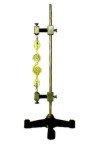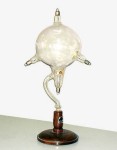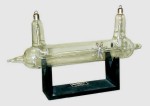
 Menu
Menu
|
School University |

|
||
|
Function To show the electric charge in very rarefied air. | |||
|
|||
|
Description Six tubes, with different pressures inside, are mounted on the same panel placed vertically on an wooden basis. The tubes are held a the bottom by a metallic strip with a binding post placed on the basis, at the top they are held by single metallic plates anchored to the panel. | |||
 Menu
Menu
|
School Spano (1), Castelvž (2) |

|
||
|
Function To show the electric charge in very rarefied air. | |||
|
|||
|
Description They are made on fluorescent glace and hold very rarefied air. These tubes of different shapes and sizes are provided with ring joints with aluminium electrodes. | |||
 Menu
Menu
|
School University (1), Spano(2) |

|
||
|
Function To study the electric discharges in a low and in a very low pressure environment. | |||
|
|||
|
Description Both have a spherical form with four electrodes and a shining wooden foot. With the first apparatus we can verify that the discharge happens following the shortest way between the two points of the current connection. With the second apparatus we can verify that the beam of cathode rays always follows the same direction whatever the anode connection. | |||
|
School Spano |

|
||
|
Function To show the mechanical action of the cathode rays. | |||
|
|||
|
Description It contains a light whirl sliding on glass guides. When it is struck by the cathode rays the whirl moves. | |||
|
School Pellegrini |

|
||
|
Function To show the electric conduction in rarefied gases. | |||
|
|||
|
Description The beam of the cathode rays comes into the central side of the tube through a slit. It is made visible by an oblique fluorescent screen when iy goes near it. | |||
|
School University |

|
||||||||||||||||||||||||||||||||||||||||||||||||||||||||||||||||||||||||||||||||||||||||||||||
|
Function To study the action of the magnetic fields on the cathode rays. | |||||||||||||||||||||||||||||||||||||||||||||||||||||||||||||||||||||||||||||||||||||||||||||||
| Description It contains a cathode at the thinner end, a metallic diaphragm with a central circular opening, and a thin mica layer covered with a fluorescent substance at the wider end. When it works, the beam of cathode rays that crosses the diaphragm, provokes the fluorescence on a small part of the mica disk, aligned with the cathode and the diaphragm hole. This demonstrates that the cathode rays go in a straight line from the cathode to the screen. If we approach a magnet between the diaphragm and the screen, the fluorescent spot moves. This demonstrates that the cathode rays are deviated by a magnetic field, and they behave as negative charged particles with great speed.
 Menu Menu
| ||||||||||||||||||||||||||||||||||||||||||||||||||||||||||||||||||||||||||||||||||||||||||||||